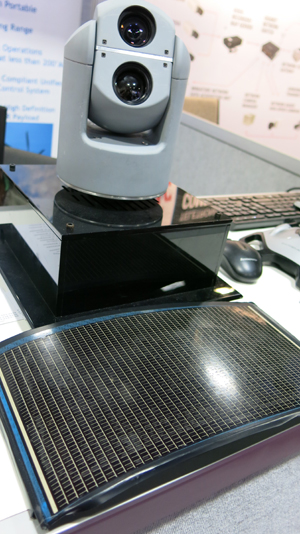

Silent Falcon UAS is introducing at AUVSI 2013 a small drone, designed to perform long endurance missions of up to 14 hours using solar power. The drone called Silent Falcon, can be launched by hand or from a vehicle, and carry a dual-sensor payload weighing about 1.3 kg. According to the manufacturer the drone has completed development and is the company is currently seeking customers to operate it in developing countries, where flight restrictions are more relaxed, enabling the drone to exploit its unique mission capabilities in security of remote areas, mineral explorations etc.
The development of the Silent Falcon began few years ago under a different company, Bye Aerospace Inc., a pioneer of solar-powered long endurance unmanned aerial systems introduced their first hybrid-UAV called ‘Silent Sentinel’ in 2009. To integrate the solar arrays in a curved form, over the upper wing area, Bye teamed with flexible solar array pioneer ‘Ascent Solar’, a producer of thin film solar arrays based on plastic surface.
Three years later ‘Silent Sentinel’ evolved into the ‘Silent Guardian’, another solar powered UAV. Few months later, the company unveiled the 27 pound latest variant called ‘Silent Falcon’, at the 2012 AUVSI conference in Las Vegas. The Silent Falcon is scheduled to go into commercial production in early 2013.
“We see this emerging electric drone market expanding rapidly, with applications ranging from military to disaster relief with rapid deployment and recovery with little risk to human life.” said John W. Brown, chief executive officer of Silent Falcon UAS Technologies, the developer of the new system. “We believe that today there is a large and growing global military and public safety agency market for small or tactical unmanned aircraft systems.” According to Brown, in these markets alone, sales exceeding several hundred units per year are possible. “As their use in these markets proves their utility and functionality and as the FAA rules for domestic commercial, civilian use become more clear, we believe the market size and number of annual units sold could increase substantially.” FAA has recently approved special flight certifications to two small drones, enabling operations in remote areas of Alaska.

The flexible solar panels that cover the upper wing area provide power for the sensors as well as the driving the 1.3-hp electric motor which spins the propeller. Extra power for the EO sensor payload is provided by Lithium polymer rechargeable batteries. The gimbaled payload carried under the belly consists of high-definition optical and infrared imagers, and a laser pointer. The sensor pod also handles video processing, letting the UAV track and identify targets, and stream images to ground stations. Silent Falcon can cruise at a speed of 12 to 60 knots and climb up to an altitude of 20,000 ft. The Silent Flacon will be hand-launched. Alternatively, a rocket assisted launch system could be employed. The drone lands on a skid or deploys a parachute that brings it safely to ground with its payload recessed to prevent damage from ground impact.

Users will be able to select different wingsets matching their Silent Falcon to a mission. The larger wings carry more solar panels, which give the plane more flight time. The smallest has a six foot wingspan carries a solar array that lets the plane fly for up to six hr. the nine foot wing will keep the drone airborne for ten hours while the largest 15 foot wing will suffice for a 14 hour mission. For comparison, the Falcon batteries limit missions to 6 hours at night.
The company is also considering developing two twin-engine variants, designed to carry heavier payloads. The SF Heavy Payload (SFHP) drone will have a wingspan of 5.2 meters and an empty weight of 15.9 kg. Carrying a payload of about 11 kg the SFHP will have a gross operating weight of 27.3 kg. Typical operating endurance will be 8-10 hours. A weaponized variant called ‘Snipe’ is also considered. According to Silent Falcon UAS, this drone will be configured as a ‘flying machine gun’, carrying a specialized suppressed weapon firing standard FN 5.7×28 ammunition at high precision from a distance beyond 200 meters.


















